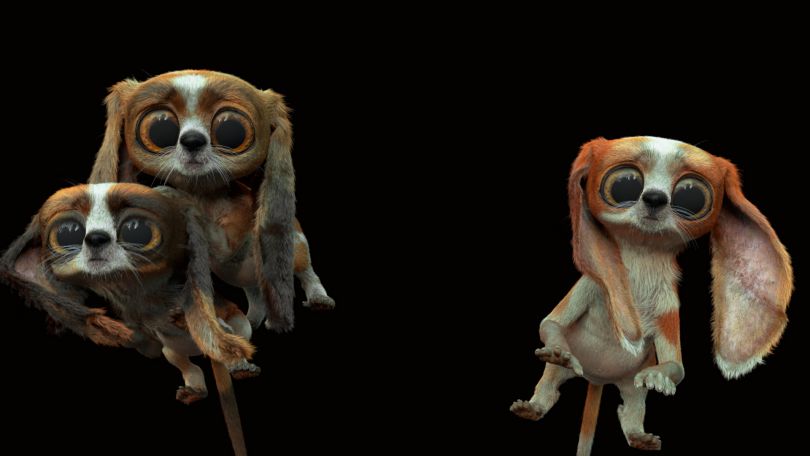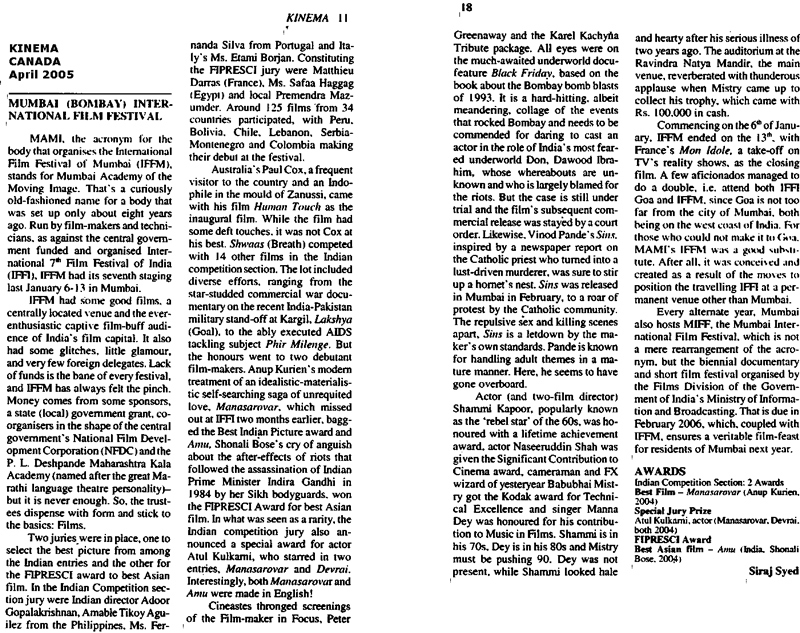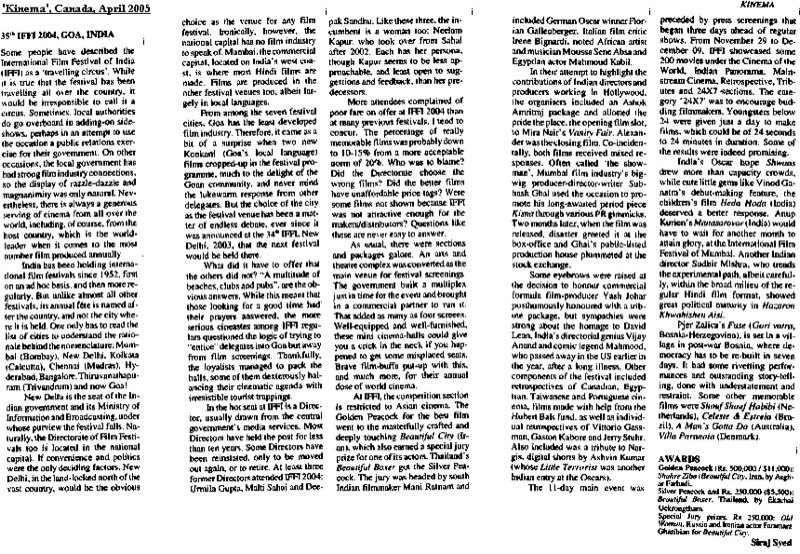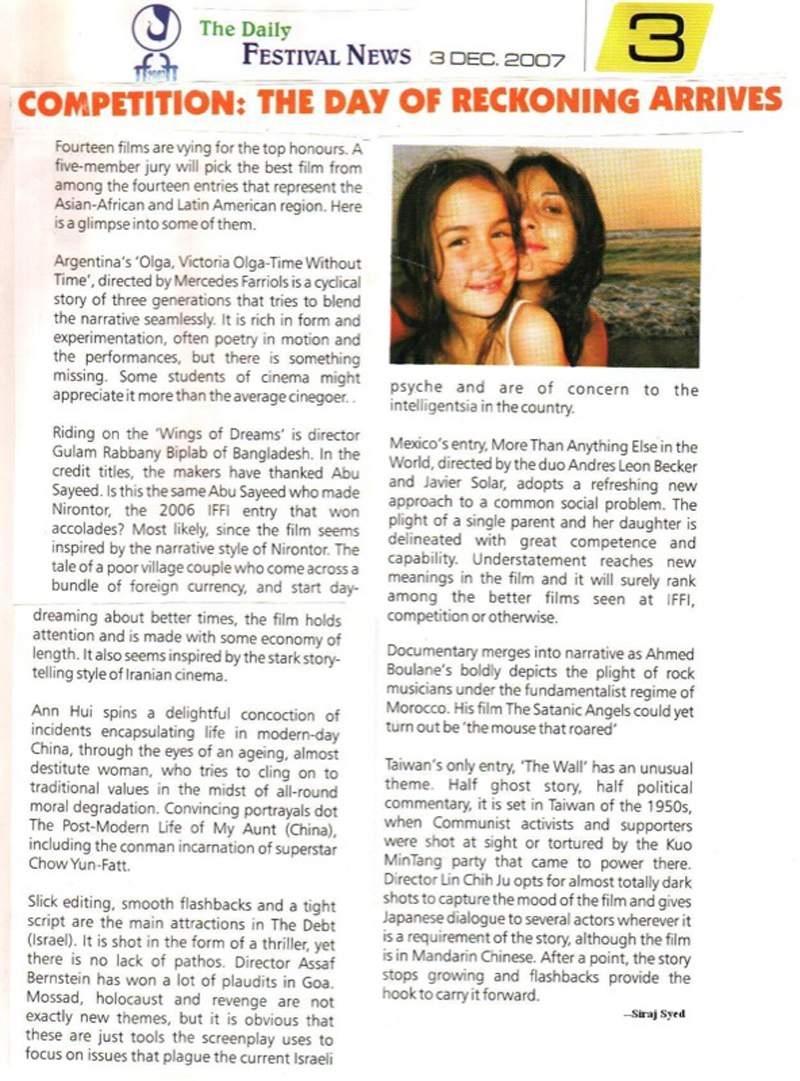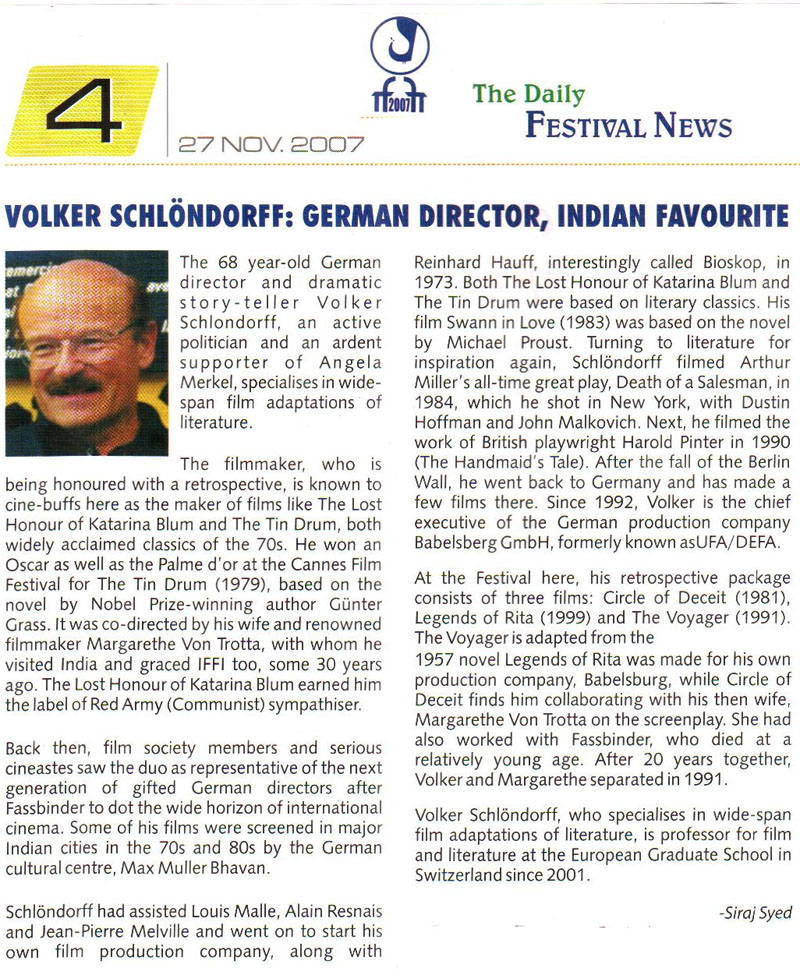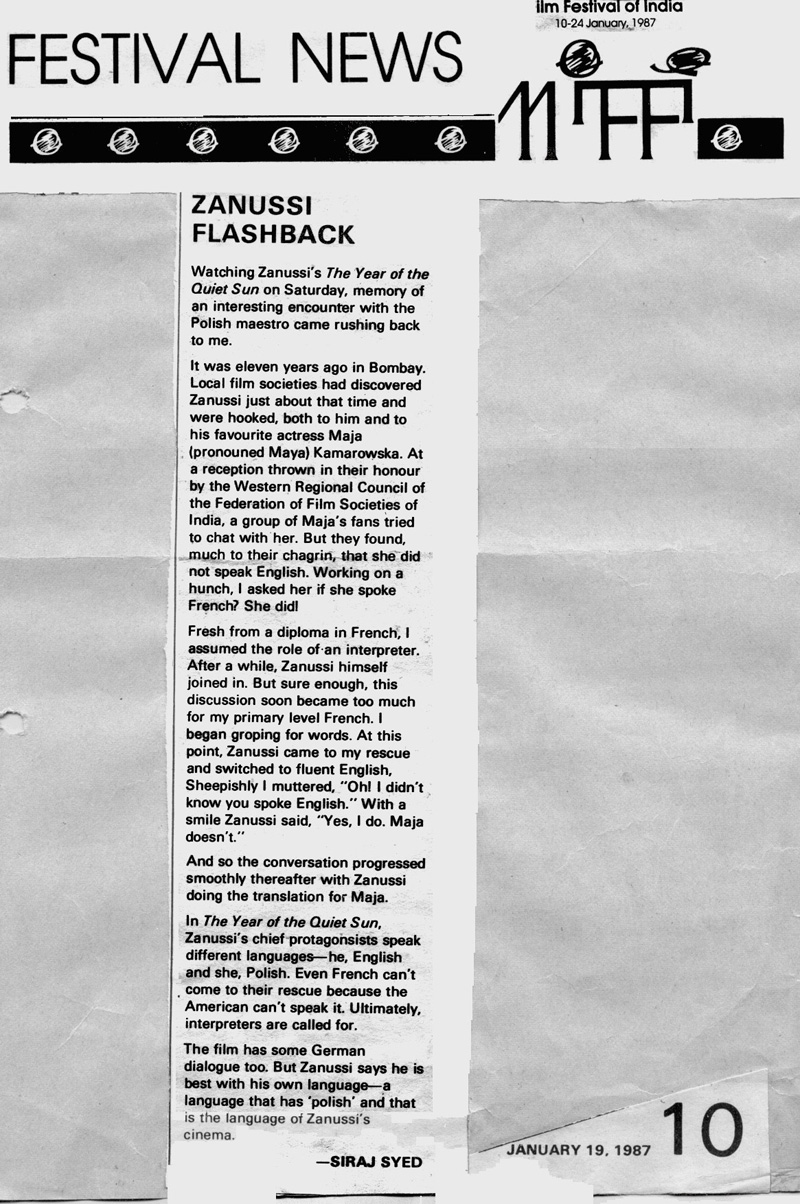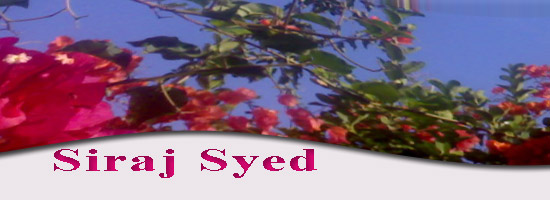|
|
||
|
Pro Tools
FILMFESTIVALS | 24/7 world wide coverageWelcome ! Enjoy the best of both worlds: Film & Festival News, exploring the best of the film festivals community. Launched in 1995, relentlessly connecting films to festivals, documenting and promoting festivals worldwide. Working on an upgrade soon. For collaboration, editorial contributions, or publicity, please send us an email here. User login |
Siraj SyedSiraj Syed is the India Correspondent for FilmFestivals.com and a member of FIPRESCI, the International Federation of Film Critics. He is a Film Festival Correspondent since 1976, Film-critic since 1969 and a Feature-writer since 1970. He is also an acting and dialogue coach. @SirajHSyed  Beauty and the Beast, Review: Beauty LIVES in the eyes of the beholder
Beauty and the Beast, Review: Beauty liVes in the eyes of the beholder Rarely does a fairy-tale manage to pack-in all the ingredients that would appeal to a cross section of audiences--stunning visuals, great special effects, mind-blowing CGI--and also portray characters as credible, in spite of being part of a fable. Beauty and the Beast is one such laudable attempt. That it comes not from Disney (who made it in 1991) or Pixar or any of the regular cartoon/animation studios is a marvel. That it is a French-German co-production is an even greater rarity, though the legend was already made in native French in 1946. Definitely recommended. In the year 1810, a financially-ruined merchant, a widower, exiles himself in the country-side, with his six children (three sons and three daughters) to avoid a ruthless creditor. One day, during an arduous journey across a forest, in the midst of heavy snowfall, the merchant stumbles across the magical and treasure-filled domain of the Beast, and enjoys his incredible and unexpected hospitality. The Beast, however, sentences the merchant to death, for stealing a rose from his enchanted flora and fauna, albeit with the noble intention of gifting it to Belle/Beauty, his youngest daughter and favourite child, a joyful girl, full of grace. When she learns about the predicament of her father, Belle feels responsible for the terrible fate which has befallen her family, including the death of her mother while giving birth to her. Belle decides to sacrifice herself by taking her father’s place, hoping to convince the Beast to kill her instead. She mounts her father’s horse and asks him to lead her towards the Beast’s realm. At the Beast’s castle, it is not death that awaits Belle, but a strange life, in which fantastical moments mingle with gaiety and melancholy. Every night, at dinner, Beauty and the Beast sit down together, but he does not eat. They learn about each other, interacting and analysing one another like two strangers who are total opposites. While she has to repulse his amorous advances, Belle tries to unravel the mysteries of the Beast and his abode. And when night falls, the Beast’s past is revealed to her bit by bit, in her dreams. It is a tragic story, which tells her that this solitary and fearsome being, who looks like a cross between a wolf, a lion and a large rodent, was once a popular prince. You will learn some 15 minutes into the film that it is more about the beauty (called Belle, as in French for beautiful) than about the beast, who really comes into his own in the second half of the film.
Conceived with the same lead pair in mind, the film finds Léa Seydoux (Inglorious Basterds, Mission Impossible-Ghost Protocol) doing a job distinctly better than her lesbian role in 2013’s Cannes Best Director winner, Blue is the Warmest Colour. The youngest of seven children, Seydoux was born in 1985. Her grandfather is chairman of Pathé films (which has co-produced Beauty and the Beast), and her mother, Valerie Schlumberger, is a former actress. Vincent Cassel, the prince/beast, has used his early training in mime express the physical manifestations of man/animal whose human face is not seen for the greater part of the film. There is good support from the rest of the cast, particularly André Dussolier as the merchant. He could have easily come across as a raving, doting, wallowing in self-pity stereo-type, had he not carried himself with dignity. You might feel, though, that the sisters and brothers tend a tad towards caricatures. Special mention must be made of the adorable little creatures called tadum, who might be products of cross-fertilisation between ET, squirrels, puppies and owls. Their alien chatter stays with you much after the film has ended. In the end, Beauty and the Beast is a triumph for director Christophe Gans, and his co-writer Sandra Vo-anh.
There are some loose ends, mainly related to the nature of the forest, the undefined power limits of its overlord and the way in which the creditor’s gang is allowed to pillage and plunder the treasure trove in the castle till the extended ending sets in, otherwise the narrative moves along convincingly and seamlessly. A highly clipped British accent, on Belle, is, perhaps, misplaced, in a film that is so essentially French. Some other characters speak with ‘accent Francaise’. The flashbacks are introduced with remarkable novelty, and this helps avoid predictability. Top angles and slow zooms, sometimes tangential and swirling camera movements--photographic tools employed to create additional dimensions and perspective--are commendably executed, to give you the feeling of 3D, of being there. Sounds are created and inserted with precision, to complete the spell and suspension of disbelief, and the transportation across time and realm.
There’s plenty in it for everyone--for all age groups, for all types of visages--the beautiful and the beastly! Rating: ***1/2 Trailer: http://www.youtube.com/watch?v=l9g2w6XPoYs Christophe Gans, Director “The first time I saw Jean Cocteau’s (French) film La Belle et la Bête, I must have been five or six. I remember having a strange feeling of dreaming with my eyes open. There was something about that film that was absolutely hypnotic, not only in terms of the image but also the sound. I added some things of my own (to the story), for example with the symbol of the arrow which, at the same time, kills the prince’s wife, then strikes him in turn. It is both an object of evil, but at the same time, Cupid’s arrow. I was struck when I saw Léa Seydoux in a small role in Robin Hood, by Ridley Scott, in which I found her absolutely sumptuous in front of the camera – the camera of a director who has great importance for me. I really wanted Belle’s point of view, and I needed an actress who is at once classical, youthful, feminine, modern, radiant and with depth. And in fact, Léa has all that and is in a class of her own. Vincent is the Beast just as you might imagine him, a sort of embodiment, at once virile, yet arrogant and ‘cyclothymic’. The combination of these two actors was really great for me because they have a really balanced ‘yin’ and ‘yang’. Léa has a masculine side, which gives her an absolutely sensational charm, and Vincent has a feminine side, which allows him to embody this character who, as I said, is grandiose, noble and a little creepy, which I think was perfect for the Beast. There’s a scene on which I had worked a great deal, in which I had invested a lot, emotionally: it was the death of the princess. It was shot in a sandpit. The poor actress was there with a minimal set, but otherwise the studio looked like an industrial wasteland. There was a sandpit, and she was naked on the ground. I had to project onto this scene – just like the actress – everything that was going to come later: the French garden, the fact that she’s an animal and that she is killed by her own husband. When Léa runs through the woods after the deer before stumbling on the rosebush, she’s running along a blue carpet with an automatic camera, which is filming on a rail with a little motor. In other words, there’s nothing there: no squirrels, no deer, there’s no moss on the ground, nothing. Shooting in Babelsberg, near Berlin, was a very moving experience for me. It was there that masterpieces of the German cinema like Metropolis, Die Nibelungen, and The Blue Angel were shot. Evenings, I would sometimes wander the set alone thinking of Fritz Lang working in the same place. Apart from the hunting scene, that starts the third flashback, which was filmed in the adjoining forest, we shot the whole film in a studio. So we filmed the hunt for half a day with the dogs, and everything else that you see is in the studio. Avatar had a great influence on me. It’s a film that I liked far beyond what I’d expected. I was very struck by the fact that here was a director who came along and created an entire biosphere from his imagination. Avatar’s strength was that the hero is disabled. It’s insane as a choice. James Cameron was smart enough to think: I’m going to create a universe which is in my head, and the hero of this universe is a man who no longer has the use of his legs, and whose inner emotions will make a hero of him. That’s a real film-maker’s way of reasoning. Jean Marais had to undergo torture in the 1946 version of Beauty and the Beast. He was daubed in glue at around 3 O’clock in the morning, which meant he developed really bad eczema, and the poor guy found himself having to project his emotions through a thick mask, which was all very problematic. In my film, the mask was made by seamstresses who attached the Beast’s hairs individually for hundreds of hours. Only this mask wasn’t stuck on Vincent’s face with glue, it was applied to his face using digital techniques. The mask was scanned in very high definition, then superimposed on the actor’s face. So the actor no longer has to get up at 4am, I don’t have to wait for him to arrive, and he doesn’t develop a horrendous bout of eczema. And he can act, because the mask isn't the same thickness as the kind of masks we had before. It’s like a second skin. The mask is literally placed like a skin over his expressions, so unlike before, the actor’s performance is respected, since the mask today is so fine. Before this film took off, I was actually working on two projects, both of which had stalled, for different reasons. One was none other than Fantomas (famous old French series, about an Inspector and an elusive criminal, starring Jean Marais) and an adaptation of Leopold Perutz’s The Swedish Cavalier. I’ve always seen the monster as an intermediary step between mortal and God. In that sense, they are indeed mythological creatures, like cyclopses, Titans, or the whole pantheon of classic mythology.” 12.11.2014 | Siraj Syed's blog Cat. : Andre Dussolier avatar Babelsberg Beauty and the Beast Christophe Gans Jean Cocteau Lea Seyroux pathé Victor Cassel Independent
|
LinksThe Bulletin Board > The Bulletin Board Blog Following News Interview with EFM (Berlin) Director
Interview with IFTA Chairman (AFM)
Interview with Cannes Marche du Film Director
Filmfestivals.com dailies live coverage from > Live from India
Useful links for the indies: > Big files transfer
+ SUBSCRIBE to the weekly Newsletter DealsUser imagesAbout Siraj Syed Syed Siraj Syed Siraj (Siraj Associates) Siraj Syed is a film-critic since 1970 and a Former President of the Freelance Film Journalists' Combine of India.He is the India Correspondent of FilmFestivals.com and a member of FIPRESCI, the international Federation of Film Critics, Munich, GermanySiraj Syed has contributed over 1,015 articles on cinema, international film festivals, conventions, exhibitions, etc., most recently, at IFFI (Goa), MIFF (Mumbai), MFF/MAMI (Mumbai) and CommunicAsia (Singapore). He often edits film festival daily bulletins.He is also an actor and a dubbing artiste. Further, he has been teaching media, acting and dubbing at over 30 institutes in India and Singapore, since 1984.View my profile Send me a message The Editor |




















